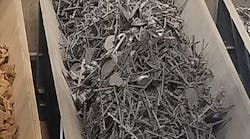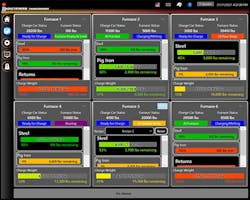Foundries typically store different scrap materials like steel, pig iron and returns in separate storage areas or ‘bins’ that are easily accessible for refills from delivery trucks. The batch-making process involves transferring charge materials from storage bins onto a conveyor using a crane. During this loading, the conveyor rests on a weigh frame that keeps track of the total amount of scrap that has been added.
For example, if the conveyor had five piles of scrap front to back, each pile or section would be considered a zone. The crane delivers additional ‘steel’ material to be placed on the pan, specifically on the steel pile at the front, or Zone 1. The crane operator follows instructions (a “recipe”) detailing the type of metal and where to place it in the pan. Each pile on the conveyor is one ingredient of the recipe.There is a difference between a scrap metal ‘material’ and an ‘ingredient.’ Material is simply scrap metal of a certain type and is only one attribute needed to fully define an ingredient. In addition to the type of material, the crane operator needs to know the required amount, the location on the pan or the ‘zone’ where that amount is placed, and the order in which the ingredients are to be added. For instance, of five piles on the pan, two are made up of steel and two are pig iron. Despite having common materials, these piles are distinct ingredients because they are placed in different zones.
Specifying zones in a recipe is important because it enforces a favorable ‘layering’ of scrap metal when it is charged into the furnace. The ingredient in zone one will impact the refractory of the empty furnace in a batch-melting operation. To prolong the life of the furnace refractory, it is advantageous to place soft, springy scrap in the front of the conveyor, followed by dense easy-to-melt scrap such as pig-iron.
On the other hand, returns that contain large, intertwined, irregularly shaped pieces, usually are placed in the back and when they are charged into the furnace there is already a molten bath to receive them.
Normally there will be a single scoreboard output, which is the “only” reference on the total amount of scrap that has been loaded onto the scale. However, when an operator is tasked with tracking multiple types of metal, the placement of ingredients, and order of loading, a single total weight display may be inadequate. This is where the Chargeminder™ system is used.
System features
The Chargeminder™ system is designed to simplify the process of loading scrap metal based on recipes. The first feature of the system is creating and editing a library of charge recipes to meet different melt requirements. A melt supervisor can pick a recipes from the library or create new recipes, as needed.
Once a recipe has been chosen for loading, the system will provide clear visual feedback to help guide the crane and magnet operators through the batch-making process. This is the second feature of the system.
Another advantage of the system is that it has no bulky, hard-to-install components. It is designed to interface easily with and enhance common scrap-weighing equipment.
System prerequisites
The Chargeminder™ system requires a receptacle that would contain the scrap as it is being loaded into the batch. Usually this will be a charge conveyor, although a charge bucket is common too. A weigh frame with loadcells is needed to sense the loaded weight and provide a proportional feedback signal. Direct feedback from the loadcells is passed to a loadcell conditioning module, which is capable of outputting a common, high-level analog signal.
System interconnection
The Chargeminder™ system fits into a foundry’s established batch-making process. Instead of being limited to a single, isolated weight display output, the weigh frames are connected to the Chargeminder™ system main console. The connection can be made directly via the analog signal from the loadcell conditioning module. Alternatively, some foundries choose to collect signals from weigh frames with a higher-level programmable logic controller (PLC.) Then, the PLC data can be shared with the Chargeminder™ system using a communications protocol such as MODBUS TCP.The Chargeminder™ system main console is installed in the melt-deck main control booth and connects to other equipment there, such as the Meltminder® 300™ system, from which it draws information on furnace status. The Chargeminder™ system also provides melt-deck operators with local feedback during the loading process. Depending on the foundry’s requirements, local operator feedback may be provided with small screens in on-board crane control booths or with smart scoreboard displays installed in highly visible areas.
The connection between the local operator and the Chargeminder™ system main console may use the plant’s automation network and wireless Internet connections – or through hard-wired connection.
Optional alloy addition
Foundries commonly add alloys to scrap metal to arrive at a desired melt chemistry. Unlike scrap metal, alloy additives usually are granular or dust-like and often are loaded using dedicated alloy-addition equipment, capable of automatically making up alloy batches based on recipes. Although the process of making up alloy batches is quite different from its scrap metal counterpart, it also relies on creating and following recipes. Therefore, to provide the melt supervisor with a single, uniform solution, the Chargeminder™ system includes an alloy recipe creation feature.
Michael Looby is the Director of Inter-Company Sales and Senior District Manager with Inductotherm Corp. Contact him at [email protected], or visit www.inductotherm.com











